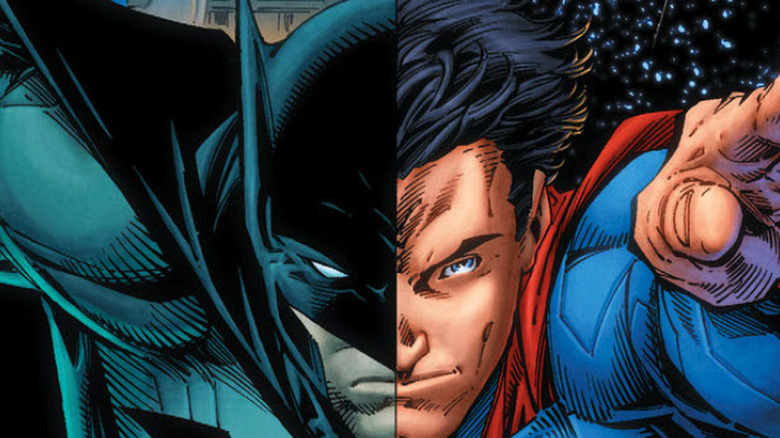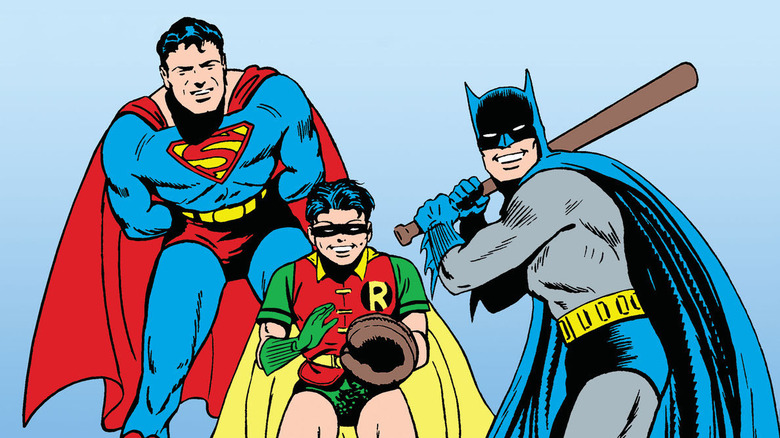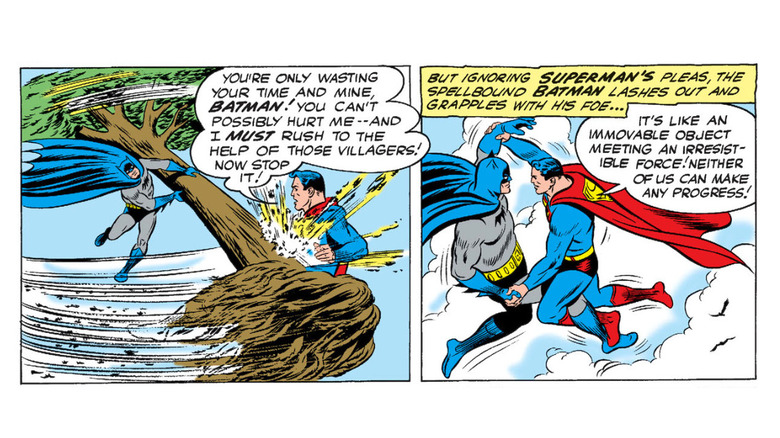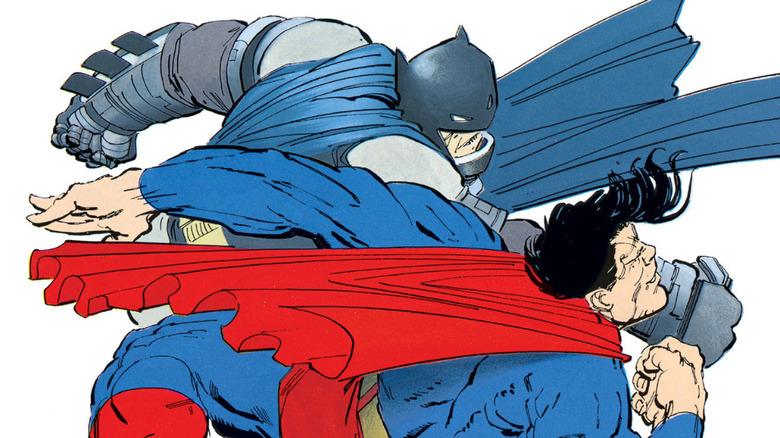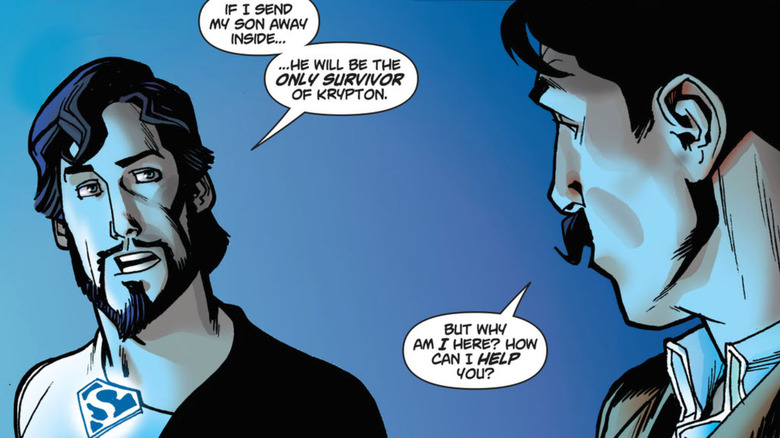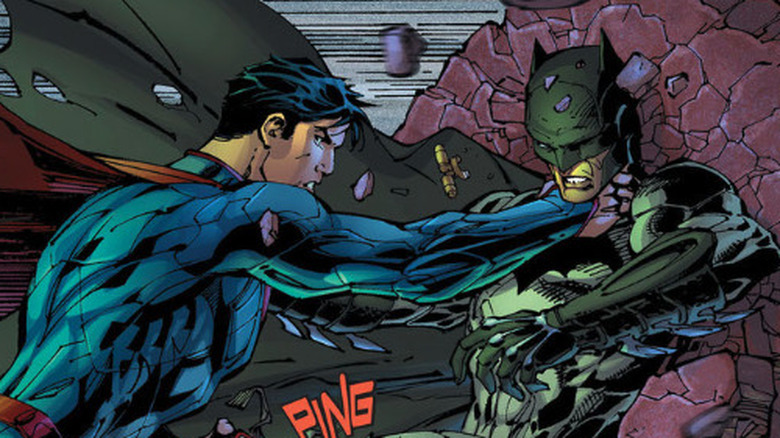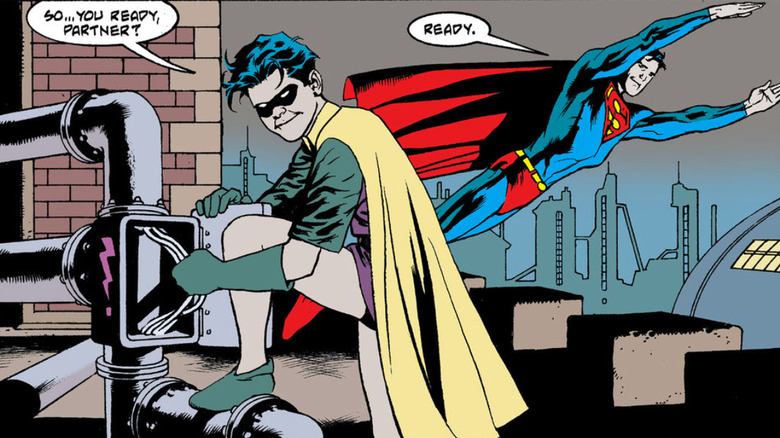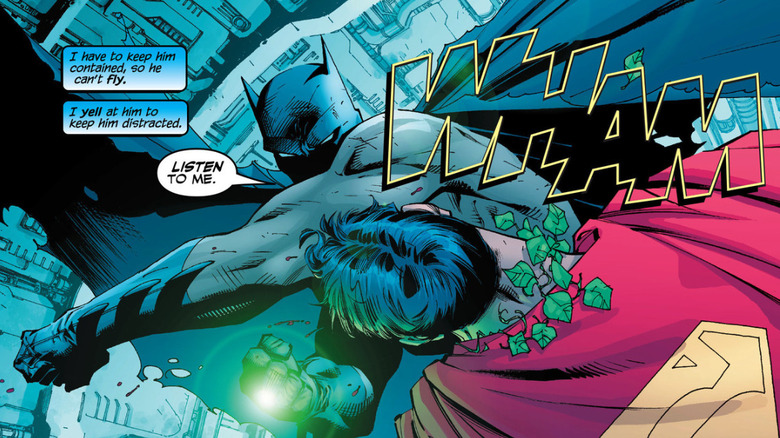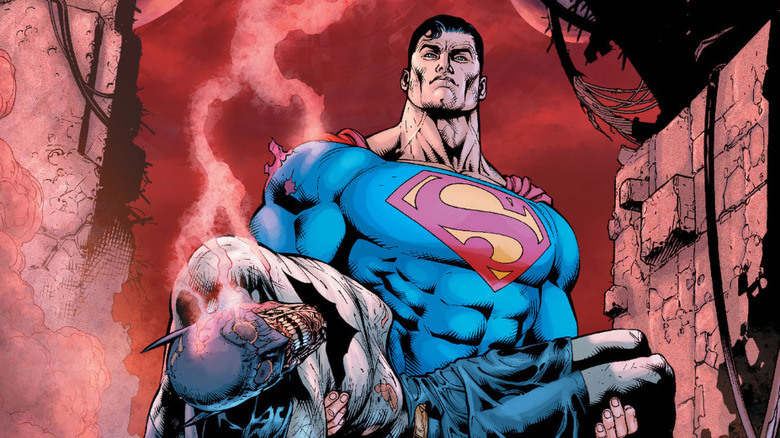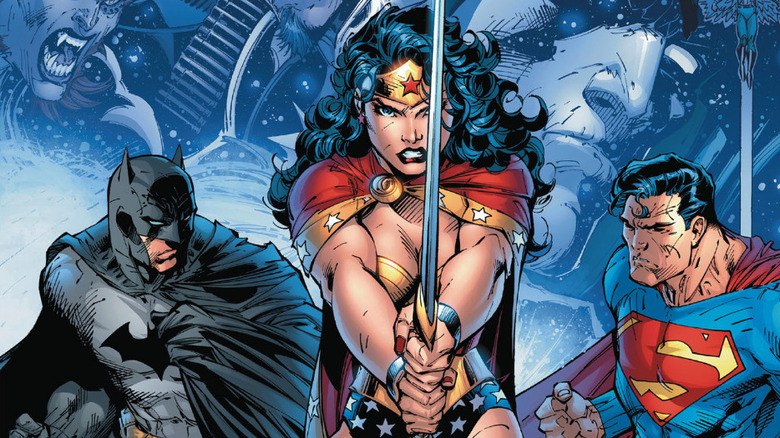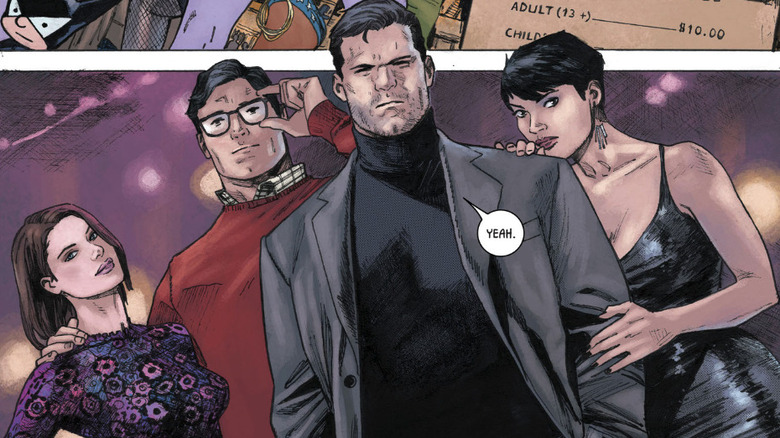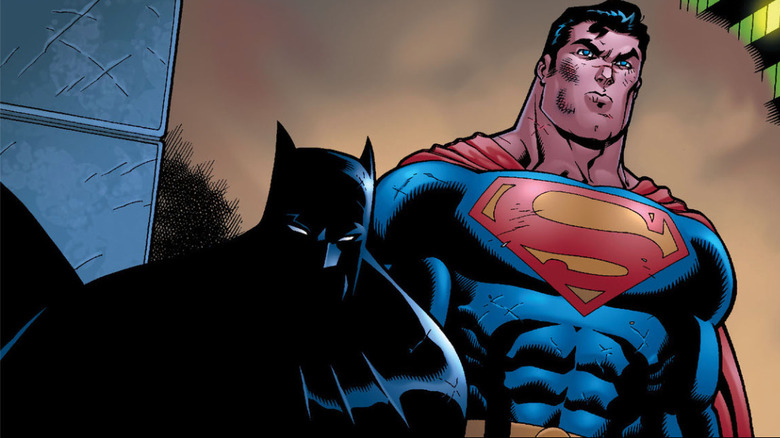The Untold Truth Of Superman And Batman's Relationship
Superman and Batman are two of the most recognizable fictional characters — not just superheroes, characters — on the planet. Debuting in 1938 and 1939, respectively, the Man of Steel and the Dark Knight have been appearing in multiple comic book titles a month for the better part of a century. While they each have their own separate stories, rogues galleries, and supporting casts, they also have a long and complex relationship within the shared DC Universe.
Some of the most popular and groundbreaking comics series have pit them against each other, but Superman and Batman are depicted as allies far more often than not, with a partnership that goes back almost seventy years.
At first glance, these two characters seem as if they should never work in the same story. One is a grim, angry detective who has trained his mind and body to the peak of human potential in the hope of bringing an end to crime and corruption in his city. The other is a smiling, godlike alien who protects the Earth from extraterrestrial invasions and pranksters from other dimensions, making even the ultimate mortal man seem positively frail by comparison. Yet, through the combined effort of hundreds of storytellers across hundreds of issues of "World's Finest," "Justice League," "Batman/Superman," and more, the pair seem inseparable.
As much as by their own stories and their own enemies, Superman and Batman have become defined by how they contrast against each other.
Batman and Superman have been depicted as friends from the beginning
By 1941, Superman and Batman had reached popularity beyond precedent, each starring in a pair of ongoing comic book titles. Looking to cash in further on their most profitable characters, the company that we now know as DC created a giant-sized quarterly anthology called "World's Best Comics," which was immediately retitled "World's Finest Comics" for its second issue. Each installment of "World's Finest" featured a Superman story and a Batman story, and the cover always depicted Superman, Batman, and Robin engaging in some sort of activity together, whether that be playing baseball or selling WWII war bonds.
Within the actual pages of "World's Finest," however, Superman and the Dynamic Duo wouldn't actually cross paths for years. To see Batman and Superman together in one story, you'd have to catch them during one of their occasional guest-starring appearances as honorary members of the Justice Society of America, such as in "All-Star Comics" #36 in 1946. It wasn't until issue #71 in 1954 that "World's Finest" became an actual team-up book, in which Superman, Batman, and Robin would engage in crime-fighting adventures together on a regular basis.
"World's Finest" would run for a total of 323 issues, featuring original Batman/Superman team-up stories with only a few interruptions between 1954 and 1986. Even as the tone and format of superhero comics evolved from light, almost sitcom-like tales of misadventure to more grounded, serialized dramas, the alliance between them was rarely shaken.
Batman and Superman have fought each other countless times
For nearly as long as fans have asked "Who would win in a fight, Batman or Superman?" DC Comics has been providing a variety of answers. Even before the characters were reinterpreted as a reluctant oil-and-water duo, Batman and Superman were pitted against each other over and over in the pages of "World's Finest Comics," beginning with issue #109 in 1960. It was a popular cover gimmick that immediately gets a potential reader curious. Why are they fighting? What's happened to even the odds between the invincible Superman and his mere mortal counterpart? The answer was usually magic, mind control, or some sort of ruse.
Once "The Dark Knight Returns" established the precedent for a more serious grudge match between Batman and Superman in 1986, it became repeated more often, and in more media. Their first fight on television was a brief skirmish during the "World's Finest" crossover between their respective animated series in 1997, they tussled again on the big screen in 2016's "Batman v. Superman: Dawn of Justice," and their conflict became playable in the "Injustice" video game series starting in 2017.
As for the question of "who would win?" the answer varies. Typically, the more time Batman has to prepare, the longer he lasts, but — dark alternate universes notwithstanding — the fight typically gets broken up before there can be a definitive victor.
The Dark Knight Returns redefined their dynamic
When they first began working together in the pages of "World's Finest" and "Justice League of America" in the 1950s and '60s, Superman and Batman were very similar characters, both do-gooders who played well with others. Superman has gained a lot of complexity since then, but is more or less still the same character. Batman, on the other hand, would receive a significant revamp beginning in 1969's "Batman #217," which sees him resume his original goal of striking fear into the hearts of criminals.
Batman's evolution into the obsessive, utilitarian vigilante continued throughout the '70s and '80s, but his new intensity would cause him to clash with the Man of Steel only rarely, such as when he resigned from the Justice League to form his own splinter group in "Batman and the Outsiders #1" in 1983.
Batman and Superman's radically different crime-fighting philosophies would come to the forefront in the acclaimed, out-of-continuity limited series "Batman: The Dark Knight Returns" by Frank Miller, Klaus Janson, and Lynn Varley in 1986. In "DKR," Superman has become a pawn of the corrupt US government while Batman is a fugitive leading a revolutionary army. Unable to reconcile their agendas, the two fight a brutal battle in the streets of Gotham. The popularity of "DKR" caused the characterization of Batman and Superman as rivals who disapprove of each others' methods to leak into the main comics continuity and, to a much greater extent, mass media adaptations featuring the two characters.
Their origins are tied together
While there are multiple stories of the first meeting between Batman and Superman, there have also been a number of tales that connect the lives of Bruce Wayne and Clark Kent before they grow into their alter egos. In 1956, "World's Finest Comics #84" revealed that Bruce Wayne came to Clark Kent's hometown of Smallville as a young man to deduce the identity of their homegrown superhero Superboy (Clark, of course), and then chose to destroy his findings rather than let them fall into the wrong hands. 1960's "Adventure Comics #275" depicted Bruce briefly returning to Smallville to fight at Superboy's side as the Flying Fox, and 1972's "Superboy #182" entangled Clark into the origin of Batman.
All of these stories were erased from continuity by the "Crisis on Infinite Earths" event in 1987, but Post-Crisis continuity would add an even more concrete association between Batman and Superman. "Superman/Batman #50" from 2008 tells the story of an unlikely meeting between their fathers, Dr. Thomas Wayne and Jor-El of Krypton. Jor-El has dispatched a space probe to Earth to determine if it would make the best home for his unborn son. This probe is discovered by Thomas Wayne. Via holographic transmission, Thomas assures Jor-El that his son Kal will be safe on Earth. Afterwards, the wreckage of Jor-El's probe unlocks the technological innovations Wayne Enterprises needs to thrive. The story implies that, without this encounter, neither Superman nor Batman would come to exist.
Their first meeting doesn't always go well
The original "first meeting" story between Batman and Superman — 1952's "Superman #76" by Edmond Hamilton and Curt Swan — is a light-hearted tale of the two heroes accidentally booking the same cabin on a cruise ship (seriously). Since then, every time the first encounter between the Man of Steel and the Dark Knight has been revised, it's been more contentious.
Superman and Batman meet for the first time in the Post-Crisis continuity in 1986 with "The Man of Steel #3" by John Byrne, in which Batman threatens to blow himself up if Superman gets too close to him — and it's not a bluff. When they meet in the 1997 "Superman: The Animated Series" episode "World's Finest," the iconic heroes trade blows almost immediately, though they figure out how to get along by the end of the three-part arc. When the core DC continuity was rebooted again in 2011, "Justice League" #2 by Geoff Johns and Jim Lee showed a more aggressive Superman immediately attacking not only Batman but Green Lantern and the Flash when he first encountered them.
Of course, this all pales in comparison to the DC Extended Universe's version in the 2016 film "Batman v. Superman: Dawn of Justice," in which they're maneuvered into trying to kill each other within hours of meeting. Batman nearly executes Superman for being a potential threat to Earth, and only stays his hand due to the startling coincidence of their mothers both being named "Martha."
Superman has also mentored Robin
Between 1954 and 1970, Superman shared adventures in "World's Finest" not only with Batman, but also Robin, the Boy Wonder. As Batman's disposition became more dark and suspicious, Superman's outgoing optimism continued to resonate with that of the original Robin, Dick Grayson, and they would occasionally team up even without the Dark Knight present. It's a natural fit, as both characters are accustomed to playing "good cop" opposite Batman's "bad cop." The Superman/Robin team-up tradition continued into Post-Crisis continuity, where the charming tale of their first meeting can be found in "Legends of the DC Universe" #6 by Kelley Puckett, Dave Taylor, and Kevin Nowlan.
Their friendship would play an important role in Dick's coming of age and establishing his own identity after outgrowing the mantle of Robin. In 1983's "Tales of the Teen Titans" #44 by Marv Wolfman and George Perez, Dick Grayson unveils his new superhero persona — Nightwing — a name selected in tribute to Superman's favorite masked hero from Kryptonian history. The two have continued to team up through each of Dick's reinventions, both during his brief tenure as Batman and as the super spy Agent 37. Superman has also partnered up with Dick's successors — though the bond is never quite the same, particularly in the case of the violent, arrogant Damian Wayne.
Superman trusts Batman to kill him
Superman may not share Batman's suspicious nature, but he understands its value. Superman knows how dangerous his powers could be in the wrong hands, and that there's always the possibility that some force could turn him into a weapon capable of subjugating or destroying humanity. As a fail-safe against this danger, Superman entrusts the only weapons capable of killing him to the one person he knows won't hesitate to use it: Batman.
As seen in 1993's "Superman: The Man of Steel" #21, Superman leaves Batman a kryptonite ring he confiscates from Lex Luthor. Batman can sometimes be seen retrieving the ring from a lead-lined buckle in his utility belt during emergencies, such as in "Batman" #612, when Superman becomes a thrall of Poison Ivy and attacks the Dark Knight.
The kryptonite ring isn't the only anti-Superman tool in Batman's arsenal, however. The Dark Knight keeps an assortment of strategies and gadgets designed to incapacitate or even kill Superman if necessary. In fact, Batman secretly keeps files on how to defeat all of his allies, which becomes a problem in the year 2000 when those files fall into the hands of supervillain Ra's Al Ghul during the "Tower of Babel" storyline in the pages of "JLA." When the villain utilizes Batman's formula for artificial red kryptonite to turn Superman's skin transparent and overload him with solar energy, it causes him unimaginable physical pain — to say nothing of the emotional toll of Batman's betrayal.
Batman and Superman have attended each others' funerals
In the world of superheroes, death is rarely permanent, which can lead to the unlikely circumstance of two men attending each other's funerals, years apart. After Superman is killed by Doomsday in 1993's "Superman #75," the world mourns his passing, culminating in a massive funeral with most of the costumed superhero community in attendance. Batman does not participate in the procession, preferring to avoid the eye of the press. He observes the burial from the rooftops, instead, and patrols Metropolis for the day in honor of his fallen comrade. Within a year, Superman's body is stolen by robots from his Fortress of Solitude and resuscitated, revealing that (by Kryptonian standards) he was never all the way dead to begin with.
Superman has been back in action for quite a while by the time Batman is apparently killed by Darkseid in the 2008 event "Final Crisis." Superman himself collects Batman's remains and returns them to the Batcave, as seen in "Superman/Batman #76." In that same issue, Superman attends a private, out-of-costume funeral service for Batman, along with Bruce Wayne's surrogate family of vigilantes and other members of the Justice League. Eventually, Batman's remains are discovered to be an extremely accurate forgery, and Bruce Wayne has, in fact, been lost in time re-living the adventures of his ancestors and gathering cosmic energy as an unwitting doomsday weapon.
In both cases, Superman and Batman grieve for each other until they are, however improbably, reunited.
When they stopped talking, the universe literally fell apart
Batman and Superman get along a solid 85% of the time, but when they don't it's bad news for planet Earth. In the buildup to 2005's crossover event "Infinite Crisis," a rift develops between Batman, Superman, and Wonder Woman. During their tiff, Superman accuses Batman of having grown too paranoid to be trusted (which is true), while Batman criticizes Superman's lack of leadership in the superhero community (arguably also true), including the barb "The last time you really inspired anyone was when you were dead." Combined with their mutual distaste for Wonder Woman's recent use of deadly force, this splits the three pillars of the DC Universe apart.
This disharmony between the leaders of the Justice League leaves the Earth vulnerable to a massive threat. Naturally, this is all part of the plan, as the conflict between them has been orchestrated by an alternate universe's Alexander Luthor in order to weaken Earth's defenses and shatter the unified multiverse back into its component realities. The trio are ultimately able to resolve their differences and defeat Luthor, but the battle leaves all three of them physically or psychologically wounded, and they each require a year away from costumed crimefighting in order to recover. In their absence, the world is plunged into World War III (as depicted in the terrific 52-part weekly series "52"). Everybody loves to see a good superhero fight, but in this case a little group therapy might have saved a lot of lives.
Batman and Superman went on a double date once
Superman and Batman don't typically mingle in social situations, mostly because Batman tends not to socialize at all if he can help it. But, over years of working together, exceptional circumstances will occasionally bring them together to do something other than solve crimes and fight alien gods. When they do actually spend off-duty hours together, they settle easily into being old friends and have a good time.
During the "Rebirth" era of "Batman" that began in 2016, Bruce Wayne enters a serious, committed relationship with Selina Kyle, a.k.a. Catwoman. Bruce and Selina attempt to find a balance between their careers as costumed adventurers and some sort of normal, functional life as a couple. They become engaged in "Batman" #32, and in issues #36 and #37 participate in a "normal couple" activity — a double date with some friends. Of course, all of Bruce's friends are superheroes, so the date is with Clark Kent and his wife, Lois Lane. Lois and Clark are both puzzled by Bruce's decision to settle down with a criminal of all people, but come to understand their connection to one another over the course of a relatively calm evening by superhero standards.
Of course, Bruce and Selina's relationship falls apart before too long, putting a halt to Bruce's exploration of normalcy and contentment — but when Bruce needs to talk so someone with a reasonably healthy work/life balance (for a superhero), Clark's only a call away.
They deeply respect one another
For all their differences, their conflicts, their brawls, and the dozens of alternate universes in which they've killed each other, Superman and Batman are allies with a deep, personal bond. They are unquestionably friends, even if Batman would hesitate to use the term. They've made great sacrifices for each other, bestowed great trust in one another, had that trust broken and reforged stronger than ever.
Even when they fail to communicate their value to each other out loud (again, this is more a Bruce problem than a Clark problem), they can often be found expressing their admiration to others, or directly to the reader through captions. Since 2003, the two heroes have frequently shared a monthly title together, either titled "Superman/Batman" or "Batman/Superman," which typically includes parallel narration from each of them. Here, in their internal monologues, it's made clear not just how much they have in common, but how much they each admire the other and how they each see their counterpart as the better man. If they fail to call each other "friend," it's because neither of them feels entirely worthy of the title. Neither can imagine having borne the other's trauma and come out the other side the hero that he is. Batman would never admit it, but there's an easy word to describe that relationship — that's called "love."
Yes, it's fun to watch the two icons throw hands — but at the end of the day, seeing them shake hands is far more rewarding.
